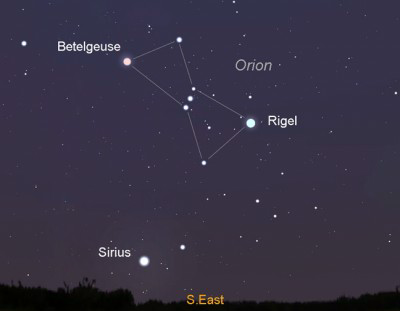Part of the Casswiki article series Cassiopaean Experiment and Natural science
Rigel (Beta Orionis). Like its rival in Orion, Betelgeuse, Rigel (Beta Orionis) is a super-giant. Its name comes from the same root as Betelgeuse’s, originally rijl Al-jauza, meaning the “foot” of al-jauza, the Arabs “Central One.” For us, the star represents the left foot of Orion, the mythical hunter.
It is usually pictured as perched upon a fainter star, Cursa (Beta Eridani), which represents the hunter’s foot stool. Though Rigel is Orion’s Beta star, it appears to us somewhat brighter than the Alpha star, Betelgeuse, perhaps suggesting that Betelgeuse was somewhat brighter in times past. Rigel ranks 7th in visual brightness, just behind Auriga’s Capella. At a distance of 775 light years, Rigel actually shines with the light of 40,000 Suns. It is a “blue supergiant,” a fairly hot star with a surface temperature (11,000 Kelvin) about double that of our Sun. Its warmer temperature gives it a bluish-white light that contrasts beautifully with Betelgeuse. If the hot star’s invisible ultraviolet radiation is considered, the luminosity climbs to 66,000 solar, the radiation pouring from a star 70 times the solar size. Rigel is accompanied by a fairly bright, seventh magnitude companion nine seconds of arc away. Normally such a star is easily found in a small telescope, but Rigel’s brilliance nearly overwhelms it.

Rigel is the brightest star in the constellation Orion
The companion, at least 50 times farther from Rigel than Pluto is from the Sun, is itself double, the components much fainter and much less massive class B main sequence stars that are fusing hydrogen into helium. With an original mass around 17 times that of the Sun, Rigel is in the process of dying, and is most likely fusing internal helium into carbon and oxygen. The star seems fated to explode, though it might just make it under the wire as a rare heavy oxygen-neon white dwarf. Rigel is a part of a large association whose stars are related by birth. The group includes the stars of Orion’s Belt, the Orion Nebula of Orion’s sword and its illuminating stars, and many of the other hot blue-white stars in the constellation.
Rigel is of special interest here since the Cassiopaeans have indirectly suggested that it has gone supernova in the relatively near past and that the optical effects of this supernova would reach Earth in the not too distant future. The same source has indicated that they use supernova remnants to facilitate the trans-density process of information transfer that is then received as channeling. The source mentioned once having used Rigel to this effect. This is of special interest since the Cassiopaeans have elsewhere indicated that the light arriving from the supernova could trigger beneficial DNA changes in certain humans.
